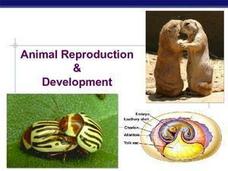Curated OER
Circulatory and Respiratory Systems Unit - Biology Teaching Thesis
Students Explain how an increased level of activity translates to cells needing more oxygen and how the lungs supply this oxygen by entering the blood stream. They also can explain that the heart is responsible for moving both oxygenated...
Curated OER
Physiology of Reproduction
In this health worksheet, young scholars examine the human body and make mental connections to the target function highlighted in the sheet.
Curated OER
Mathematics in Bioengineering: Its Application for Today's Students
High schoolers explore the different fields of bioengineering. They will create and interpret graphs from cancel cells data. They then calculate the amount of drugs found in blood and eliminated by the body over time.
Curated OER
Circulatory System Design
Students identify the different parts of the circulatory system and their function. They work together to create their own model of the system and use it to determine the rate of blood flow. They answer questions related to their model.
Curated OER
Sex-Linked Genes and Disorders
In this genes worksheet, students determine how the gender of a baby is produced plus explore sex-linked disorders such as hemophilia. This worksheet has 20 fill in the blank and 8 short answer questions.
Curated OER
Run the Circulatory System Relay
Students examine how blood travels through the circulatory system. They act like they are partcipating in a race throughout the system identifying the components as they go. They write a creative story to end the lesson.
Curated OER
Circulatory Systems
Excellent diagrams, labels and summaries make this resource be valuable to your students throughout the topic of circulation. All types of circulation vessels are explained, their structure and function is detailed, and the overall...
Curated OER
Enzymes Help Us Digest Food ~ Introduction to Sugars and Enzymes
After an explanatory introduction to sugars and enzyme activity, biochemists discover whether lactase is needed to digest lactose, sucrose, and milk as a whole. High school science lab skills are required for these investigations.
Pleasant Valley Community School District
Integumentary System
This document can be used as a slide show to introduce your human body systems class to the integumentary system, also know as skin. Topics outlined include the roles of skin, details about its its layers, and color (cause and...
Curated OER
Integumentary System: A System, An Organ, the Biggest!
It is only six short slides, but an acceptable outline of the integumentary system. General facts about the system, layers, sublayers, and functions are listed as bullet-points. What would make this presentation more engaging for your...
Curated OER
Mountaineering: How Our Bodies Acclimatize
In this mountaineering and acclimatization worksheet, students read about the changes that take place in the blood as the body acclimatizes to high altitude. They answer three critical thinking questions about acclimatization.
Teach Engineering
How Antibiotics Work
Take two pills and call me in the morning. The first lesson in a short unit of four introduces class members to delivery methods of medicines. The instruction introduces the question of which delivery method is best to get you feeling...
Curated OER
Animal Reproduction and Development
Details of fertilization, cleavage, the placenta and fetal development are presented, along with important diagrams and illustrations. By using these slides, you and your students will generate discussion points, along with details...
Curated OER
Review for Strand 2A Test: Nervous System
Three pages containing 51 true and false questions make up this nervous system review. The major topics listed at the top of the test mention a film strip and a laboratory activity, but the questions appear to be answerable without...
Curated OER
Chromosome Karyotyping
Students explore chromosome karyotyping. In this chromosome karyotyping lesson plan, students use a chromosome kit to explore chromosome syndromes and disorders. They also produce a large model of a cell with chromosome to simulate cell...
Curated OER
Tissues
In this tissue learning exercise, students are given notes on 6 types of epithelial tissues, 10 examples of connective tissue, three types of muscular tissue and the components of nerve tissue.
Curated OER
Anatomy Review
For this biology worksheet, learners examine the internal functions of the human body while considering the factors needed to explain the physiological reactions.
Curated OER
Antigen Switching in Malaria
Students model how the malaria-causing protist avoids immune response in its host. In this parasite biology lesson, students use printed cell images to model the way that Plasmodium changes surface protein markers every few generations...
Curated OER
Respiration, Circulation, and Excretion
In this body systems worksheet, students place 11 vocabulary words into a word puzzle by matching the terms with their definition. The vocabulary words are review of the respiratory, circulatory, and urinary body systems.
Curated OER
Gas Transport
In this biology worksheet, students examine the transport of gases in the circulatory system and how they bond to hemoglobin.
Curated OER
How Can We Extract Human DNA?
Students perform an experiment in which they extract DNA samples from hair samples. They follow a set procedure to extract the DNA and complete summary questions.
Curated OER
Antigens
Students examine antigens including ones found in humans. In this immune lesson students complete several experiments in relation to antigens and antibodies.
Curated OER
Biology Trivia
In this biology trivia worksheet, students write short answers to 101 questions about animal classification, human anatomy, animal facts, and attributes of organisms.
Curated OER
Early Filtrate Functioning
In this biology worksheet, students look at the function of filtering in the nephron of the kidneys and the biochemistry is emphasized.























